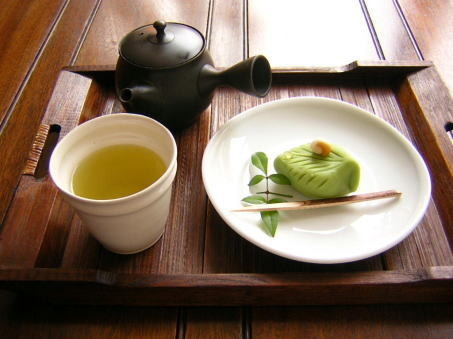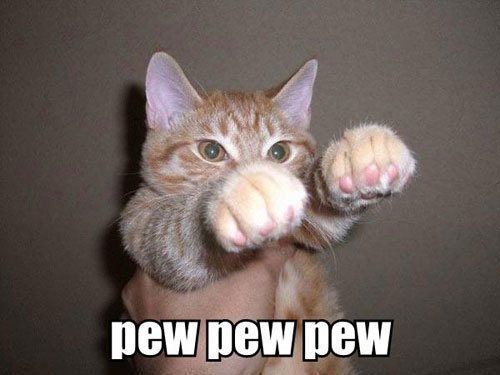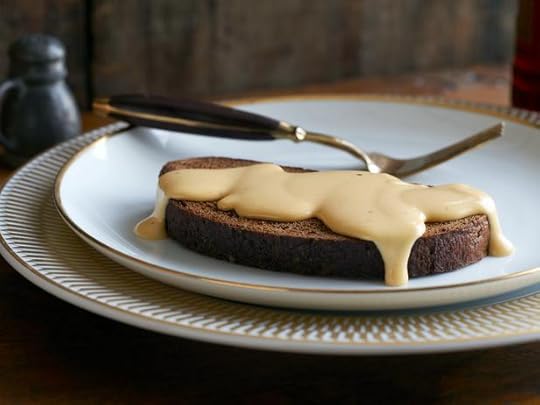Yangsze Choo's Blog, page 4
April 25, 2013
Self Control is Good for You
Since the arrival of our children, my husband has been steadily pushing a variety of child-rearing books on me. Thoughtful, interesting books like Po Bronson’s Nurture Shock, and Brain Rules for Baby. Unfortunately, I haven’t read any of them.
“Why don’t you read them, instead of this…this Japanese comic book about baseball?” he said in exasperation. Despite my protests that I had no emotional bandwidth for anything else, as I was deeply immersed in my fantasy of being a starting pitcher at Koshien Stadium, I had to admit he was probably right. In fact, from what I could tell from the points he summarized for me, those child-rearing books are really quite useful.
One of the things they stress is that self control/the ability to delay gratification is one of the greatest predictors of success. Now, if self control means a child who can do his homework without being chased around the dining table like a wild horse, then I am 100% for it. But that’s not all. Apparently it’s not too late to apply this lesson to myself.

Time to spray horticultural oil!
“I don’t have any problems getting things done!” I said indignantly. Why, just this morning I went out and sprayed the apple tree in our backyard against codling moth. I even, despite my unfortunate resemblance to a Jawa, donned gloves and protective gear to do this. Then I wandered around watering the roses and deadheading them etc. etc. Inspite of this flurry of activity, I have to confess that none of this was necessary. In fact, my real work (consisting of numerous emails, bills, and memos to be written) was still waiting, pristine and untouched, on my desk.
Verdict: a FAIL for delayed gratification, since gardening is something I enjoy.
And let’s not even talk about writing. Various family members have pointed out that this blog has very little about the actual process of writing.
“Aren’t you supposed to be an author now?” they said accusingly. “Why isn’t there anything here about your ‘craft’”?
I don’t have a good answer to that, other than I can’t imagine that people really want to know what I do when I’m writing. Other novelists, like Hemingway, seem to have had far more glamorous lives that bled into their writing. In my case, instead of exterminating big game on the plains of Africa, I was busy eradicating apple moths.
Aside from this, I am actually trying to write my second novel and must agree that self control is incredibly helpful if you’re going to embark on a long-term project like a book. For instance, you have to control the urge to make numerous trips to the fridge. (I’d like to point out that while writing this blog post, I’ve only strayed twice to retrieve some cheese and a slice of mortadella). You also have to resist temptations like reading cat blogs and googling Korean celebrities.

The fruits of this morning’s idle labour
For years, I only wrote short stories to entertain friends and family. I never thought I’d have the discipline to write a novel, but somehow or other I kept going on. And on. And on. Until I’d written 170K words (then I discovered, to my horror, that apparently no agent will look at a book that’s over 120K words and had to start slashing – but that’s another story). To be honest, I don’t recommend this method of producing massive, doorstop-sized manuscripts. But I am thankful that I kept writing, even when I felt like screaming and running away. Now if only I could replicate this self-control for my second book…
Book Suggestion:
The Old Man and the Sea, Ernest Hemingway. The epitome of self control in the struggle between man and fish.
Snack suggestion:
Thin slivers of Manchego cheese, or a slice of ham – anything that can be eaten quickly and with little distraction. No carbs (which will make you lie down for a “quick” snooze)!
Photo credit: Photo 1-http://www.funnyjunk.com/funny_pictur... Photo 2: Star Wars.
What do you find most challenging to your self control?
If you enjoyed this post, please share with friends or follow me on FB!


April 9, 2013
I Want a Handsome Butler
I’ve been thinking very hard about my priorities, and have finally come to the conclusion that what I really, really want is a handsome butler.
Not a Roomba — a friend was recently extolling the virtues of her robotic vacuum cleaner and how it cleans the floor while she’s out, but I was already shaking my head. Robotic vacuum cleaners would merely suck up pieces of Lego that my children can’t live without, like the One Ring which came with the Hobbit set. No, as I know only too sadly from personal experience crawling around on the floor, what’s needed is a sentient intelligence which can instantly sort out the rubbish from “my precioussss”.
I’m not looking for emotional attachment, as I’m already quite attached to my husband — just level-headed, pleasant professionalism. Someone who can cook expertly, sew on missing buttons the proper way with a button shank, and iron my clothes until they’re devastatingly crisp. Other duties would be to chauffeur me around, remind me discreetly of appointments, and address me as “Milady”. On top of that, I’m expecting some serious eye candy.
As you can see, I’ve clearly spent too much time thinking about this. About as much time as I used to spend on idle questions such as “which superpower would you prefer to have?” (by the way, if you ask anyone this question, they will tell you right away, as though they too have been mulling over flying vs. invisibility for decades). This shift from superpowers to super-butler probably has a lot to do with age and, unfortunately, responsibilities.
Of course, I could do what I normally do and let things slide. I’ve already fallen far, far below S.E. Asian standards as my sister discovered to her horror, when she visited and found that I no longer iron my t-shirts. And since I work from home, I told her cheerfully that I only wear yoga clothes and sweat pants because “it helps me write” (an absolute lie).
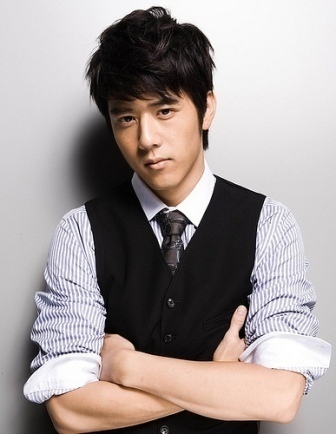 Still, I have to admit that when we went out together, I couldn’t help admiring her cute outfit accessorized with dainty sandals. She looked adorable. I looked like…well, at least I was comfortable. And that’s precisely why I need a butler. I don’t want to continue this sloppy lifestyle! To do so however, you definitely need some kind of household help. The sort that’s struck a chord with the 50 million other fans of Downton Abbey, although nobody seems to have daydreams about being a scullion at Downton despite the historic odds being higher.
Still, I have to admit that when we went out together, I couldn’t help admiring her cute outfit accessorized with dainty sandals. She looked adorable. I looked like…well, at least I was comfortable. And that’s precisely why I need a butler. I don’t want to continue this sloppy lifestyle! To do so however, you definitely need some kind of household help. The sort that’s struck a chord with the 50 million other fans of Downton Abbey, although nobody seems to have daydreams about being a scullion at Downton despite the historic odds being higher.
For 99.99% of human history, it has actually been physically impossible for one person to get all the housework done by themselves. If you look at the evidence, even poor people hired servants part-time, or if they couldn’t afford to, certainly didn’t have a “house” of their own to maintain. Group living, with all its attendant joys and horrors, was the norm along with back-breaking chores like washing clothes and hauling water.
“So how did the ancient Romans manage?” my 7 year old asked.
“They had slaves!” I answered. Wealthy Romans even had body slaves — people whose sole purpose was to trot alongside their masters, scrub their backs, dress them, and carry them around in litters.
Now I am totally against slavery, especially since I’m forced to act as a personal body slave to 2 small children most of the time. But I don’t see anything wrong in hiring a professional to help out. The only problem is the fees, plus the fact that most butlers were old and “uncle”-like because they had to train for years. At this rate, I’m just as likely to get a handsome butler as I am to fly. But it doesn’t mean I won’t think about it…a lot.
The Remains of the Day, by Kazuo Ishiguro
Snack Suggestion:
Anything not made by you, served on a beautiful tray with a sprig of green.
Photo 1: Clive Owen in Gosford Park, Premiere Magazine 12/8. Actually, I think he was a footman, not a butler. Photo 2: George Hu as “Hayate, the Combat Butler”. Photo 3: http://deens-japan.com
Would you rather fly, be invisible, or have a handsome butler?
If you enjoyed this post, please follow my blog, FB, or :)


March 26, 2013
The Long Winter of Beans
I was preparing to write something serious and literary when I happened to weigh myself this morning. To my horror, I discovered that I had mysteriously gained several pounds overnight. I rushed out to confront my husband.
“Did you notice –?”
“Me too!” We shouted simultaneously.
Despite attempts to convince ourselves that our bathroom scale was broken, I could only conclude that our izakaya excesses had taken their toll. In some ways, I’m amazed at how far society has come. At no other point in history has food been so plentiful yet readily abused. My 7 year old tells me that his classmates who get the school hot lunch routinely toss most of it, unopened, into the garbage. Although I’m appalled by this waste, I can’t say I blame them since school lunch tends to be heavily processed food encased in plastic. There’s no such thing as a school cafeteria here, and not even the pretense of cooking. I volunteer once a week and can’t help but be boggled by the food supplied, such as a corn dog and chocolate milk. A corn dog, for those unfamiliar with this uniquely American phenomenon, is a hot dog dipped in corn batter and deep fried on a stick. I don’t know how this fairground treat became acceptable as a lunch staple for small children, but it was probably passed by the same bureaucrats who decided that ketchup qualified as a school “vegetable”.
In stark contrast to this, we’re reading The Long Winter at home, the seventh book in Laura Ingalls Wilder’s “Little House” series, which details in simple, clear language the hardships of a particularly bad winter on the prairie. The strengths of this book, like all the others in the series, lie in its interesting and heartfelt narrative which captures the bleakness of pioneer life without depressing the reader. But what I’m particularly struck by is the food. The Ingalls family, even during the best of times, seem to subsist on mostly fat salt pork, bread, pease porridge, and whatever game Pa can hunt. Treats like white sugar and white flour cakes are described in loving detail as the rarities they were, and fresh vegetables are only available in summer.
Now, I’m not very familiar with American history so I was intrigued by this diet, which seemed crushingly monotonous and dependent on dry goods brought from “back East” and a wheat harvest. In The Long Winter, when the trains stop running due to blizzards, the townsfolk are in danger of starving to death and Laura’s family is reduced to eating a few shriveled potatoes and brown bread made from wheat ground in a coffee grinder. I’m sure it was not a good diet, and it makes me wonder what condition their teeth were in. (By the way, whenever anyone asks me “what time period would you have liked to live in?” I always answer “Now, of course.” Nobody seems to think about the wonders of dental care or laparoscopic surgery whilst channeling Cleopatra, but I really don’t think they should be overlooked).
So when my kids clamored to eat a “historical meal”, despite the temptation to serve them a boiled potato and a piece of brown bread, I decided to give them beans instead. Kale and white bean soup is readily made in bulk and, if the recipients are easily enthralled, can be fed to them day after day.
Me: “You lucky, lucky pioneers! We had a great bean harvest this year and we’re having kale and bean soup!”
Children: “Hooray!”
Day 2: (packed as school lunch with bread and butter and a bit of pork sausage)
Me: “This is what German peasants ate. Rich ones too — notice the sausage?”
Children: “Hooray!”
Day 3:
Me: “Bad news, the potato harvest has failed. We’re going to starve. What shall we eat?”
5 year old (anxiously rummaging in fridge): “There’s some soup left!”
I’m sure you get the idea… Unfortunately, I don’t think this method is going to work much longer but I’m going to milk it while I can (although it’s rather tiresome to spend dinner time pretending to be a peasant). But beans are much, much better for you than a corn dog. Maybe if I stuck to them I might be able to fit back into my favourite skirt soon.
Book Suggestions:
The Long Winter by Laura Ingalls Wilder
Down and Out in Paris and London by George Orwell — another book which makes me grateful for the food that’s so easily available to us.
Snack Suggestion:
Kale and white bean soup – I like this recipe, and often add fresh tomatoes. No need to separate the ribs from the kale leaves if you chop it finely enough and add the kale at the same time as the beans so it cooks longer.
Photo 1: Some heirloom beans I got at the farmer’s market. The cute ones that look like orca are called Badda, and the other ones are Hutterite. Photo 2: Kana Okada via cookinglight.com
What under-appreciated food do you like to eat?
If you enjoyed this post, please follow my blog or :)


March 14, 2013
Why This Should Be a Cat Blog
I had many good intentions to get some work done when I stumbled upon a blog purportedly written by a cat. Now, the internet has loads of things to offer, but I had never suspected that cat blogs (and presumably dog blogs, hamster blogs, tortoise blogs etc.) might have proliferated so much. Well, perhaps I should have been warned, given the success of a little book called I Can Has Cheezburger Now?
“Who reads these things?” I said, even as I continued to peruse it. An hour later, having bounced from one cat blog to another via pictures of cute animals, I had to admit defeat. The cat blog is a brilliant idea and if only I could get away with it, my life would be much easier. Now, I don’t currently have a cat, but I have had one in the past. Along with several dogs, rabbits, hamsters, fighting fish, tortoises and various birds. I don’t know what my parents were thinking, but I shall always be grateful for a childhood filled with animals (the only one they refused was an exotic black and white rodent known as a Japanese dancing mouse).
In any case, what I noticed was that:
All cat blogs seem to have a similar persona. That is, an unreliable sort of feline who refers to humans as “servants” or “minions”.
It is perfectly acceptable (even expected) for the cat blogger to make irrational demands for food, playthings, and the right to sit on your head.
The cat blogger never has to worry about spelling or grammar, as any combination of letters will serve as long as it gets the point across. Thus, something like “no mor cat fud, fool!” is considered a perfectly reasonable reminder to go grocery shopping.
Finally, the cat blogger delivers all communications as a RANT.
Put together, this was beginning to sound like a rather attractive package to me. For example, on days when I was frustrated from doing traffic duty at my kids’ school, I could post a picture of an angry cat saying “I iz running u over with my lawn mower, if u iz not staying on the crosswalk!!” If I didn’t feel like cooking dinner, then I could send my husband an email with a plaintive cat saying “Pleaz giv me sushi tonite.”
Broadening the horizons, I wonder if my agent will allow me to write cat books instead. Unfortunately, given the short feline attention span, they would probably be one line novels like this:
On existential angst (with bonus reading guide): “Mous iz my frend but I haz eaten him. Discuss.”
Clearly, there’s lots of potential here, but I think I may have give it a pass. Not least because it’s going to be hard to keep coming up with cat pictures if I don’t have one at home. And since our household has severe cat allergies, it doesn’t look like it will happen soon. However, please don’t be alarmed if you occasionally find posts written by “Yangsze Mew”.
Photo credit: Photo 1: http://www.tumblr.com/tagged/ginger%20cat Photo 2: http://www.fanpop.com/clubs/cats/imag...
Wud u reed a cat blog?
If you enjoyed this post, please share, follow my blog or :)


March 11, 2013
Childhood Books that Frightened You
The other night, I was up reading a Japanese manga that was loosely based on Oscar Wilde’s The Picture of Dorian Gray. I don’t know whether it was the lateness of the hour or the fact that the story seemed much more horrific rendered as a black and white graphic novel, but I was almost too frightened to turn the pages. This was despite knowing the outcome and the fact that there was almost no gore, simply the slow metamorphosis of a painting into the face of evil.
Sadly, I’m quite a chicken and can’t watch horror movies, but books are usually fine because I can skip the scary parts. This is a problem, however, with graphic novels because as fast as you flip the pages, you can’t help but see some of the illustrations. I’ve now learned my lesson and will not be reading any more manga marked “horror” — at least, not without a peanut butter sandwich to cover the pages as I turn them.
Growing up, I read a lot of Victorian classics: M.R. James, J. Sheridan Le Fanu, Carmilla etc. The best of these produced a thought-provoking suspense — a chill finger down your spine, as opposed to senseless, Hollywood-style violence. I was reminded of this when I was in the library picking out books for my kids, and my hand happened to hover over Alan Garner’s The Owl Service. The last time I read this book I was about 10 years old and it left a very strong impression on me. So I wondered whether I would still find it as disturbing if I read it again.
Winner of the 1967 Carnegie Award, The Owl Service begins when Alison and her new stepbrother Roger come with their parents to spend the summer at an old house in Wales. Gwyn, the housekeeper’s son, finds an old dinner service — plates with owl patterns — in the attic that triggers a whole series of events. Alison copies the patterns onto paper, which turn into owls and disappear, and the three young people begin to reenact an ancient tragedy. Lleu Llaw Gyffes, a hero of The Mabinogion, has a beautiful wife made for him out of flowers. Bloduewedd doesn’t love him, however, preferring another man named Gronw Pebyr. In the end, both men kill each other, though Lleu is resurrected and Bloduewedd turned into an owl as punishment. The book is infused with a brooding sense of fatality, as scratches in the attic lead to the increasingly erratic behaviour of the three teens. And in the background, the local Welsh villagers stand by, waiting for the deaths to recur as they have every generation.
As a child, I was frightened by the anger of the woman, Bloduewedd, who flies around tormented as an owl. ”She wants to be flowers but you make her owls. You must not complain, then, if she goes hunting,” is one of the cryptic utterances in the book. Rereading it however, I found it very different. It is a surprisingly adult novel, dealing with themes of social status and infidelity. The real story is the resentment between the local Welsh and the English, which is not only cultural but also economic and class-based. The story moves forwards in fits and starts, sparse in detail and heavy on dialogue, like a strange broken dream. If I hadn’t read so much Dylan Thomas or had a couple of Welsh teachers when I was a child, I would have been completely confused by this book. As it is, I’m still somewhat baffled.
I can’t imagine a book like this being published now for children. As an adult, I find it unsatisfying and elliptic. Still in my childhood memories, this book has a haunting presence that far out-shadows its present self. The funny thing is that when I started looking up other people’s reviews on the internet, many of them said the same thing. “It frightened the heck out of me as a child”. Why, then, doesn’t it do the same to an adult?
My theory is that its very vagueness is what terrifies children. That, and the fact that it hints of trouble in the adult world – prejudice, money, and betrayal. The book gives you the sensation of eavesdropping on secrets, even though they are never quite defined. Something horrible is happening in the background and the adults in the book are well aware of it though they refuse to explain. Rereading the book, I want all these issues to be resolved, which is why the ending seems bland. But for a child reading this, perhaps the real fear is that of the adult world.
Snack suggestion:
Welsh rarebit — melted cheese poured over bread (click on picture for Alton Brown’s recipe)
What are some books that scared you as a child, and do they still frighten you?


March 7, 2013
Bacon, Mon Amour
I’ve been having a hard time concentrating all day because the house smells like bacon. This is nobody’s fault but my own, since between bouts of “working” at my computer, I’ve been rushing off to fry batches of bacon. All for the sake of seasoning my new cast iron skillet.
For years, I’ve contemplated adding a cast iron skillet to my collection of cookware. Now, this is a serious investment because we live in a small house and the cupboards in my tiny kitchen are bursting with pans and dishes. Collecting kitchenware is a weakness of mine, balanced out by the fact that I buy very few clothes. Who needs clothes when you’re saving up to buy a Kuhn Rikon pressure cooker? My husband is unimpressed, saying that he’d rather I bought a nice pair of stilettos instead of some frightening, pressurized pot, so a (second) pressure cooker is currently off limits. Which brings me back to cast iron.
A cast iron skillet is a solid piece of history, from way before things like tri-ply stainless and ceramic infra-red coatings. It’s also incredibly heavy and needs to be seasoned before use. I had been looking for something to replace my nonstick pan and given my space constraints, ended up buying a petite 8″ skillet just right for crisping up some corned beef hash topped with two oven poached eggs. But first, I had to season it.
Chowhound and Cook’s Illustrated were filled with dizzying advice about how to season cast iron. Some people advocated burning off the factory pre-seasoning by sticking it in the oven and setting it on “clean”. Others said you should build a bonfire and leave your skillet in until it turned white hot. Still more purists argued that vintage cast iron was the only way to go. Then there were pages and pages of discussion about the right sort of oil to use, from flaxseed to lard. I felt so overwhelmed that I had to eat some dark chocolate to revive myself.
As a child, I recalled seeing my mother season a new cast iron wok. She slowly fried grated coconut in it, stirring and scraping until the house was full of a nutty aroma and the wok had taken on a glossy black sheen. This seemed like a fairly straightforward proposition, but not having any freshly grated coconut on hand, I decided to make do with bacon.
 My skillet was so small that I could only fry 2 rashers of bacon at a time, but I figured that the long, continuous frying time could only help. And so it was that I was trapped in the house, frying dainty portions of bacon for much of the day. Make sure you scrape often with a metal spatula to ensure a smooth finish. The house was permeated with a sizzling aroma and I was forced to open all the windows plus the front and back doors. Stumbling around in this lard-induced atmosphere, I was beginning to feel a little high and starting to think disjointed thoughts of pioneers who survived on skillets of beans and fat salt pork.
My skillet was so small that I could only fry 2 rashers of bacon at a time, but I figured that the long, continuous frying time could only help. And so it was that I was trapped in the house, frying dainty portions of bacon for much of the day. Make sure you scrape often with a metal spatula to ensure a smooth finish. The house was permeated with a sizzling aroma and I was forced to open all the windows plus the front and back doors. Stumbling around in this lard-induced atmosphere, I was beginning to feel a little high and starting to think disjointed thoughts of pioneers who survived on skillets of beans and fat salt pork.
Cast iron is fantastic at making crisp, deeply coloured bacon that looks like it belongs on the cover of a magazine. And at the end of this marathon bout, I drained the fat and tentatively slipped in a sliced tomato. Success! It didn’t stick at all. Then I fried an egg which stuck only slightly. I ate all of them, including several rashers of bacon and part of a baguette. It was very good.
The most interesting development (apart from having a house that smells like one of Three Little Pigs has been smoked in it) has been my personal popularity. Eau de Bacon is apparently a captivating scent. Dogs wandered across the street to greet me. My children rushed to hug me with squeals. “Mummy, you smell so nice today!” And my husband enthusiastically spun me around when he came home. Best of all, I have a giant stash of crispy bacon in the fridge. Ah, bacon, mon amour. The love that keeps on giving.


March 4, 2013
A Visit to My Publisher
Last week, I was lucky enough to escape from my children and go on a brief trip to New York with my husband. It was also a chance to visit my publisher for the first time.
It still amazes me to not only have a wonderful agent, but also (unbelievably) a real publisher. So when I arrived in front of the HarperCollins building on a cold and rainy day, I was starstruck and couldn’t resist taking a number of photos, none of which were particularly in focus.
My editor met me in the lobby; we had exchanged emails, phone calls, and revisions but it was such a treat to finally meet her in person. As we exited the lift, she remarked that the building was very “Mad Men” and that they were due to move offices next year, but I was too busy gaping at the large, movie-poster size book covers that adorned the hallways. Books by famous authors like Isabel Allende, Elmore Leonard, and Neil Gaiman. I had the urge to rush up and touch the glass, but luckily we went in to meet some people from publicity and marketing instead.
Sitting around a table with three attractive publishing professionals was slightly surreal. On one hand, we were discussing a product that would be launched in August. On the other hand, this product was literally a figment of my imagination. It raised a lot of questions about the exact moment when something as ephemeral as a thought becomes reality. In the meantime, I thoroughly enjoyed talking to them and was vaguely surprised that I hadn’t been evicted yet.
 Later that afternoon, I went with HarperCollins’ charming audio producer to do a test reading for the book. Visiting the recording studio was the culmination of all my NPR fantasies, and the experience of being directed by a real director, with a real audio producer, and a real sound engineer, was both nerve-wracking and so much fun that I couldn’t stop beaming. We ran through two chapters and the upshot was that I’ll be narrating the audio book for The Ghost Bride.
Later that afternoon, I went with HarperCollins’ charming audio producer to do a test reading for the book. Visiting the recording studio was the culmination of all my NPR fantasies, and the experience of being directed by a real director, with a real audio producer, and a real sound engineer, was both nerve-wracking and so much fun that I couldn’t stop beaming. We ran through two chapters and the upshot was that I’ll be narrating the audio book for The Ghost Bride.
“Is it going to be abridged?” I said, looking at the pages of dense text and wondering which idiot had written it. Oh, that would be me.
“No,” they said. “We don’t really abridge books nowadays. Most readers prefer the original copy.”
The actual recording will be done in a studio in California later this spring, and I suspect it’s going to be a challenging, yet memorable undertaking. Why are there so many characters in this novel and how am I going to make voices for all of them without sounding like a muppet? These are some of the Deep Questions that I clearly didn’t ponder when I leaped at the chance to do a test reading. There’s loads of Chinese dialects as well, including one which I don’t speak.
When I mentioned this to a Singaporean friend with whom we had dinner that night, he said, “And why is there Hainanese in your book?”
“Because the cook is Hainanese.” In colonial Malaya, people from Hainan entered the cooking profession in droves.
“Aiya, why did you do that? My own mother is Hainanese and I can’t even speak it!” he pointed out.
 I really had nothing to say, other than the fact that I never expected this book to be published, or made into an audio book, let alone read by me. I shouldn’t tell you all these things, lest you give up hope and nobody buys the audio book, but really, truth is stranger than fiction.
I really had nothing to say, other than the fact that I never expected this book to be published, or made into an audio book, let alone read by me. I shouldn’t tell you all these things, lest you give up hope and nobody buys the audio book, but really, truth is stranger than fiction.
If I had thought all those years ago when I was hosing down the cafeteria floor in university or staring at a financial spreadsheet with bloodshot eyes, that I might actually have the kind of job where I could wander through the doors of a New York publisher and fool them into letting me read my own book, then I might have planned it a little better. But I am deeply, deeply grateful for the way things turned out.
So, if you are secretly writing a manuscript in the dead of night, or pondering plot points while your children race around the house like circus ponies, I want to encourage you to keep on writing. These things can actually happen, so don’t give up!
I’d like to thank my wonderful editor and the rest of the team at HarperCollins and John Marshall Media for making time for me last week. And a big hug for my mother-in-law for watching those ponies, er, children while we were away.
What’s your impossible dream?
If you enjoyed this post, follow my blog or :)


March 1, 2013
Automated Plane Food
It’s been a while since I traveled on Virgin America, so I was quite excited to find out what their airline food was like. Now, strictly speaking, it seems that US domestic flights don’t “do” food anymore. Instead, travelers are encouraged to buy small plastic-encased portions of food at inflated prices. I’m not complaining about this, as I’m hopeful it makes my air ticket cheaper, but there’s a certain part of me that’s nostalgic for the fancy aeroplane meals that come on trays.
As a child, I recall looking at advertisements for Malaysian Airlines which showed beaming travelers tucking into lobsters, and though nobody has ever offered me anything other than “chicken or beef?”, I still cling to that hope. In the meantime, there’s something charming about doll-size portions of meat and vegetables, all neatly laid out on a sectioned tray. I also love the midnight service of cup ramen, which is the best part of an international flight to Asia. There’s a certain frisson to clutching a styrofoam cup of steaming MSG in a hushed and eerie darkness, dimly lit by the flickering images from other people’s movie screens.
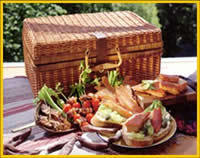 Unfortunately, there was no cup ramen on my cross-country flight and in the morning rush, I only managed to pack a few sad-looking ham sandwiches and some clementines. It’s too bad as I’ve always had secret visions of whipping out a luxurious picnic hamper, like the unfortunate prostitute in Guy De Maupassant’s story “Boule de Suif”, and nibbling on delicacies like duck confit nestled in a bed of fennel and apple salad on my tiny fold-out table. Or carving thin slivers of salami or Manchego cheese. Such daydreams are unlikely, however, since I didn’t even remember to pack napkins, let alone a gigantic basket stuffed with foie gras. Besides, nobody is allowed to carry pocket knives on board anymore.
Unfortunately, there was no cup ramen on my cross-country flight and in the morning rush, I only managed to pack a few sad-looking ham sandwiches and some clementines. It’s too bad as I’ve always had secret visions of whipping out a luxurious picnic hamper, like the unfortunate prostitute in Guy De Maupassant’s story “Boule de Suif”, and nibbling on delicacies like duck confit nestled in a bed of fennel and apple salad on my tiny fold-out table. Or carving thin slivers of salami or Manchego cheese. Such daydreams are unlikely, however, since I didn’t even remember to pack napkins, let alone a gigantic basket stuffed with foie gras. Besides, nobody is allowed to carry pocket knives on board anymore.
I was excited to discover, however, that you can now order food through your individual touch screen TV and pay for it by swiping your credit card. Giddy that humanity was finally moving towards Willy Wonka’s visionary TV chocolate, I studied the menu. Virgin America has clearly tried to position itself as a trend setter. The usual suspects of chips and nuts are redeployed under the guise of “Artisan Cheese Box” (cheese and crackers) and “Protein Meal” (nuts and energy bars). Not to be outdone, I pressed the button for “Non-GMO caramel popcorn sprinkled with sea salt” (100cal) and waited. It arrived in precisely in 3 minutes, brought by a passing stewardess. Later, I also ordered some dried fruit and nuts mashed together and Pringles. Each came in under 5 minutes, delivered in the same noiselessly unobtrusive manner.
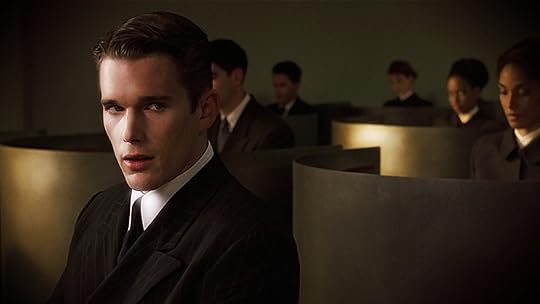 It was an odd experience, yet strangely addictive. Looking around at my fellow travelers, all of us feverishly tapping away at screens and tablets, I was reminded of the sci-fi movie Gattaca, which offers an achingly well-designed future filled with silent hallways and people hurrying away on some kind of business. I don’t know whether the people behind Virgin are forging into this futuristic ideal, or whether they’ve drawn their inspiration directly from movies, but the result is a kind of self-fulfilling loop, where a picnic basket (a la Guy De Maupassant) probably doesn’t make carry-on size limits.
It was an odd experience, yet strangely addictive. Looking around at my fellow travelers, all of us feverishly tapping away at screens and tablets, I was reminded of the sci-fi movie Gattaca, which offers an achingly well-designed future filled with silent hallways and people hurrying away on some kind of business. I don’t know whether the people behind Virgin are forging into this futuristic ideal, or whether they’ve drawn their inspiration directly from movies, but the result is a kind of self-fulfilling loop, where a picnic basket (a la Guy De Maupassant) probably doesn’t make carry-on size limits.
What’s your favourite airline food?
Images: Photo 2: http://www.elliotthousebandb.com/gour... Photo 3: Still from the movie “Gattaca”


February 22, 2013
Hot Korean Dumplings
Emboldened by my success in locating the secret Adult World kalbi butcher, I was curious to discover what else might be lurking around that mysterious strip of stores. It turned out that there were no less than three large Korean groceries in close proximity, which made me very happy as one of my hobbies is going to supermarkets and buying food. There’s nothing like wandering around the fluorescent lit aisles, admiring the seafood and fondling the vegetables.
One of these supermarkets has a sweet potato seller in the front, and for a couple of dollars you can walk away with a steaming paper bag of roasted sweet potatoes. I always get some when I go by, telling myself that sweet potatoes are really a sort of superfood etc. and so much healthier than cake. Of course, this logic doesn’t work when my next stop is at “Paris Baguette”, a frothy Korean daydream of a Parisian bakery. The pastel-coloured cakes, swaddled in whipped cream, are so adorable that it’s always a struggle between eating and squeezing them.
At the very back of the sweet potato supermarket is a small independent stall that sells mandu, or dumplings (I don’t know why there are so many of these random stores within grocery stores that sell everything from cosmetics to odd clothing, but they exist, just in case you want to buy some false eyelashes along with a nice piece of brisket). It’s run by two friendly Korean ladies who make the mandu and steam it on the spot.
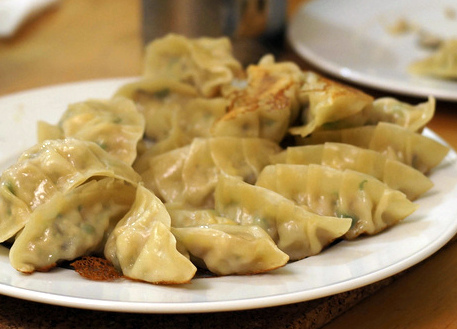 I have a weakness for dumplings, particularly the Korean variety which I sometimes make at home. However, the disparity between the number of dumplings our family wants to eat, and the number that I can actually make is so depressing that this has become my go-to place to buy them. Note: if you want a steady supply of home-made dumplings, you should start your children young. My family had no such tradition and so I’m resigned to the fact that I’ll never be as speedy as my friends who were former child-labourers.
I have a weakness for dumplings, particularly the Korean variety which I sometimes make at home. However, the disparity between the number of dumplings our family wants to eat, and the number that I can actually make is so depressing that this has become my go-to place to buy them. Note: if you want a steady supply of home-made dumplings, you should start your children young. My family had no such tradition and so I’m resigned to the fact that I’ll never be as speedy as my friends who were former child-labourers.
The best way to eat these pre-steamed dumplings is to take them home and pan fry them until they are golden and slightly crispy. Served with a dipping sauce of vinegar and soy sauce, you’ll find that small children (who were previously engrossed in redecorating the house with Lego) will greet you with cries of delight.
 My report on the joys of this neighborhood would be incomplete without mentioning The Face Shop. This is an outlet of the popular Korean high street cosmetic store, and is fully stocked with every kind of potion for a beautiful complexion. Guiltily, I’m tempted to go in each time I stagger past, laden with my bags of sweet potatoes, cake, and mandu. What makes me hesitate is the life-size cardboard cutout of Kim Hyun Joong. At first, I wasn’t sure why he was advertising cosmetics. However, a closer inspection reveals flawless skin, doe-like eyes and glossy lipstick. This creates a similar sort of dilemma as the cakes. You don’t know whether you’re supposed to date him, or be him.
My report on the joys of this neighborhood would be incomplete without mentioning The Face Shop. This is an outlet of the popular Korean high street cosmetic store, and is fully stocked with every kind of potion for a beautiful complexion. Guiltily, I’m tempted to go in each time I stagger past, laden with my bags of sweet potatoes, cake, and mandu. What makes me hesitate is the life-size cardboard cutout of Kim Hyun Joong. At first, I wasn’t sure why he was advertising cosmetics. However, a closer inspection reveals flawless skin, doe-like eyes and glossy lipstick. This creates a similar sort of dilemma as the cakes. You don’t know whether you’re supposed to date him, or be him.
In my case, I’m so far gone into auntie-hood that I could only gaze enviously at his airbrushed complexion. I wouldn’t mind looking like a nubile twenty-something. We even have the same hairstyle. My husband has other opinions. “NO! I don’t want you to look like a guy!” But is he really? Coyly posed behind a tree, he sends conflicting signals. I think on the whole, I’d prefer some older “uncle” type like Lee Byung Hun.
Snack Suggestion:
Mandu – If you can’t find a convenient freshly-made source, here’s a recipe from a blog that I love.
What’s your favourite type of dumpling? (Either for squeezing or eating)
If you enjoyed this post, follow my blog or :)


February 18, 2013
The Art of Eavesdropping
For Valentine’s day, my husband took me to a Japanese izakaya for dinner. The restaurant was so enormously popular that after waiting an hour for a table, we were finally given one in a private room which was clearly a table for 4 divided by a makeshift screen. This meant that we would be sitting right next to some other couple, but pretending we were at two different dinners. Due to the routine Chinese practice of squeezing around overcrowded tables with strangers, or perhaps my own incurable nosiness, this was not a problem at all. In fact, it promised to be quite interesting.
When the other couple finally showed up, they turned out to be French. By happy chance, this was one of the languages I was forced to learn during a childhood spent shuttling between countries. It’s a horrible, mongrelized French, the sort that produces semi-illiterate essays liberally marked up in red, but it’s enough to eavesdrop and my husband knows it. So while our neighbors were murmuring to each other in the language of eternal lovers, he looked meaningfully at me. What are they talking about?! his eyebrows signified. I could hardly blame him. Who wouldn’t want to know what two French people were discussing on Valentine’s Day, especially when they seemed so intense and gesticulated from time to time?
When dinner was over, I made my report. “It was all about food.”
“What?”
“He kept saying that he wanted to try dishes that were more a la Japonaise, but she ordered the wrong things.”
“And the arguing?”
“That was about the asparagus.”
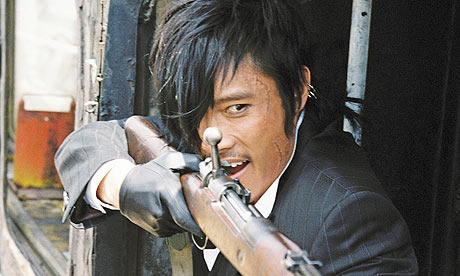 “Oh.” As we headed out (I had thoughtfully left my high heels at home so that I could eat more without toppling over), I recalled the time I was eating lunch by myself at a Korean restaurant and couldn’t help overhearing a juicy conversation involving adultery, embezzlement, and some incredibly evil but good looking guy. My eyes were getting rounder and rounder and I had given up all pretense of eating my sul long tang, when it dawned on me that the speaker, a middle-aged Korean auntie, was enthusiastically recounting the plot of a popular Korean drama. I was terribly disappointed by this, particularly as she talked about it as though it had all really happened to people she knew.
“Oh.” As we headed out (I had thoughtfully left my high heels at home so that I could eat more without toppling over), I recalled the time I was eating lunch by myself at a Korean restaurant and couldn’t help overhearing a juicy conversation involving adultery, embezzlement, and some incredibly evil but good looking guy. My eyes were getting rounder and rounder and I had given up all pretense of eating my sul long tang, when it dawned on me that the speaker, a middle-aged Korean auntie, was enthusiastically recounting the plot of a popular Korean drama. I was terribly disappointed by this, particularly as she talked about it as though it had all really happened to people she knew.
Perhaps a little more fuzziness (or an extra beer) would have produced better stories. Then I could have imagined that the passionate French couple was planning to run away together instead of debating the merits of vegetables. And that life really can resemble a soap opera complete with psychotic Korean heart throbs.
Photo 1: http://flic.kr/p/bQqvJ2, Photo 2: Still from The Good, the Bad, and the Weird. I’m pretty sure she wasn’t talking about Lee Byung Hun, but that’s whom I was picturing…
What’s the most interesting thing you overheard at a restaurant?
If you enjoyed this post, please follow my blog or :)



